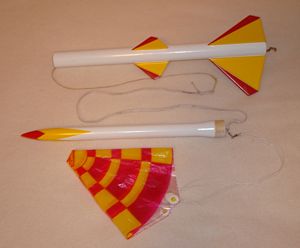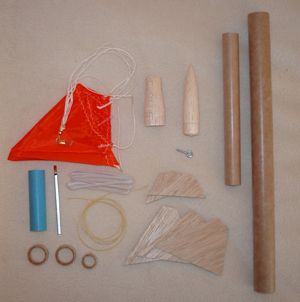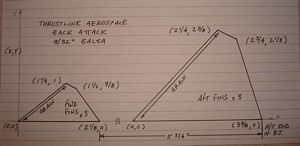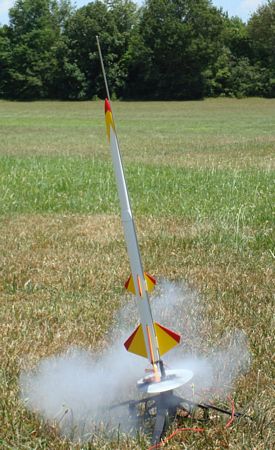Thrustline Aerospace Zack Attack
Thrustline Aerospace - Zack Attack {Kit}
Contributed by Matthew Bond
| Construction Rating: | starstarstarstarstar |
| Flight Rating: | starstarstarstarstar_border |
| Overall Rating: | starstarstarstarstar_border |
| Manufacturer: | Thrustline Aerospace |

Brief:
Having recently re-energized my addiction to rocketry, I was faced with the task of recreating the core of my
previous rocket fleet. Thinking back, I realized that a great many of the rockets that I liked to fly were the designs
of John Rowan-Stern at Thrustline Aerospace. Unfortunately, Thrustline was no longer in business this time around (a
situation that has since changed) and so with RockSim and EMRR as my primary resources, I began to clone my favorites.
The Zack Attack was one of Thrustline's earliest designs. It consists of a BT-50 base transitioning to a BT-20 payload section with 2 sets of fins, flies on 18mm motors, separates at the transition, and recovers on a 12" chute. Like many of John's designs, the Zack Attack "fit" my eye in terms of size, scale, and line, and with the RockSim file downloaded from EMRR, I started my build.
Construction:
The parts needed to clone the Zack Attack are simple and readily available. A fin template picture is included with
this review so anyone can build it. The following parts are required:

- BT-50 Body Tube – 12.75 inches
- Balsa Transition BT50/20 – I used a Semroc TA 2050A
- BT-20 Body Tube - 7 inches
- Nose Cone – BNC-20N
- BT-20 Motor Mount Tube – 2.75"
- Centering Rings CR20/50 – I used the heavy paper type
- Standard length engine hook
- Thrust Ring – CR-5/20 Centering Ring
- 3/32" Balsa Sheet
- Shock Cord System – I used 24" of 100lb Kevlar® and 24" of 1/8" sewing elastic
- Launch Lug – 1/8" x 2"
- Small Screw Eye – Attaches shock cord to payload section
- Recovery Device – Your choice, the original kit came with a 12" Mylar parachute
The Zack Attack was a fairly simple build. It's maybe just a tick harder than skill level 1 due to the fact that you need to align two sets of fins, but there were no real tricks and I would imagine that anyone who has built a kit or two could get this done without any trouble. My standard routine was to put together the engine mount first, which included cutting a slit in the motor tube for the hook, gluing the thrust ring into the forward end of the motor tube, securing the engine hook to the motor tube with a wrap of masking tape, and then glued the centering rings to the motor tube approximately 1/2" from each end of the tube. At this time I also attached the Kevlar® shock cord to the motor mount by tying it around the motor tube between the centering rings then cut a small notch in the outside of the forward centering ring to allow the cord to reach the front of the rocket. Finally, I reinforced the centering ring to motor tube joints with glue fillets.
While the motor mount glue was drying, I cut out the fins, making sure I knew where the leading edge was to get the grain orientation right. A sharp knife and a metal straight edge made this task very simple. The two sets of like fins were stacked together and sanded so that they were identical, and the leading and trailing edges were rounded off.
Installing the motor mount was next. First, I threaded the Kevlar® back through the motor tube to keep it out of the way, and test fit the motor mount to make sure it slid easily into the body tube. Next, a ring of glue was swabbed inside the body tube near where the forward centering ring would rest, and the motor mount slid into position with the aft end of the motor tube even with the aft end of the body tube. After the glue was dry I added a fillet to the aft centering ring where it meets the body tube. At this point I sanded the body tube to scuff up the glassine coating, which I believe helps the gluing/finishing process.
 There are several methods for marking the body tube for fin/launch lug placement. I usually
save the fin marking guides from all the kits I build so a rarely have to come up with a new one. I used a section of
small aluminum angle from a local hardware store to extend my fin/lug lines. The aft fins for the Zack Attack were
attached even with the aft end of the body tube and the forward fins were attached 5.75" from the aft and of the
body tube in line with the aft fins. The launch lug is cut into two pieces which were attached 1" and 6.5"
from the aft end of the body tube. The fins and launch lug were attached with wood glue using a double glue joint, and
reinforced with wood glue fillets.
There are several methods for marking the body tube for fin/launch lug placement. I usually
save the fin marking guides from all the kits I build so a rarely have to come up with a new one. I used a section of
small aluminum angle from a local hardware store to extend my fin/lug lines. The aft fins for the Zack Attack were
attached even with the aft end of the body tube and the forward fins were attached 5.75" from the aft and of the
body tube in line with the aft fins. The launch lug is cut into two pieces which were attached 1" and 6.5"
from the aft end of the body tube. The fins and launch lug were attached with wood glue using a double glue joint, and
reinforced with wood glue fillets.
The forward payload section is assembled according to your own plans for flying this bird. I personally don't have any plans to fly a BT-20 sized payload so the nose cone and transition were permanently glued in place. The screw eye was attached to the transition by screwing it part way into the base, removing it, adding a large drop of medium thickness CA glue and then screwing it all the way down. Final assembly included tying the elastic cord to the Kevlar® line and then tied to the nose cone with a drop of thin CA glue on all the knots.
Finishing:
My original Zack Attack kit did not come with any decals or recommended paint scheme--heck, the instructions were in
black and white so you couldn't even steal John's colors. I originally planned on copying the scheme of my original
Zack Attack, but after I got the first coat of color on the fins, I went a different route and was happy overall with
the results. I used Elmer's Wood Filler to add smooth fillets to the fin and launch lug joints. The nose cone,
transition, and fins were sealed with two coats of Elmer's Wood Filler thinned with water and sanded smooth. My
standard finishing routine is 2 coats of primer (Rustoleum Painter's Touch Sandable Primer) and then 2 coats of Krylon
spray enamel, working down to 400 grit sandpaper before the final coat. I have had decent success using standard 3M
masking tape for my paint jobs. As long as I always cut a new edge on a clean cutting surface and remember to rub the
edges down before the first coat of paint, the results have been good.
Construction Rating: 5 out of 5

Flight:
Recommended motors for the Zack Attack include the standard range of black powder 18mm Estes/Quest Motors. I have yet
to find the courage to put an 18mm composite motor in my Zack Attack, but I'm sure that would be quite a ride. Flight
preparation is standard: add some wadding, load up the recovery device, install the motor, insert the igniter, and head
to the pad. My original Zack Attack flew six flights in all kinds of conditions. The majority of those flights were
with C6-5 motors which will push this rocket to around 900ft. My new Zack Attack has flown on all the recommended
motors, and while it is a nice small field flier on an "A" or "B" motor, a C6-5 is still hard to
beat. The nice thing about this rocket is that it looks good on the pad, it looks good in the air, and it won't get
completely out of sight on BP motors so you'll be able to fly it over and over.
Recovery:
The original kit came with an unassembled 12" Mylar parachute, which held up through many flights with only a
few small burn/melt through spots. Even though the chute is packed into the lower section of the rocket there is still
plenty of room to keep it clear of the worst of the ejection charge. My new Zack Attack clone uses a 12" plastic
chute from Semroc because that's what I had on hand and recovers just fine, even in moderate winds. The only issue I
have ever had with this design is that when the forward payload section is deployed by the ejection charge, it is
susceptible to damage from hitting the aft section/fins. The problem is compounded on windy days since the design is a
bit overstable and will arc into the wind, leading to faster deployments. My original Zack Attack picked up a couple
nice creases and paint marks on the forward section due to deployment strikes. So far my new Zack Attack has come back
clean, even from some arcing flights on windy days.
Flight Rating: 4 out of 5
Summary:
One of Thrustline's earlier designs, this one hasn't been re-introduced yet, so is still a good candidate for a
cloning project.
PROs: Basic rocket that is a small step up from 3FNC with a great "look", good performance, and simple construction. This is a pretty well thought out design. The motor selection and recovery system are well matched to the size of the rocket.
CONs: None really, except for the fact that you can't buy it anymore (for the time being...) The forward payload section is susceptible to damage during the ejection event.
Overall Rating: 4 out of 5
Other Reviews
- Thrustline Aerospace Zack Attack By Matthew Bond
Brief: This is a medium priced skill level 2-3 rocket with a payload section as designed by Thrustline Aerospace. Construction: Parts included with this kit were a balsa nose cone and transition piece, a body tube plus a smaller upper payload tube, engine tube, engine hook, centering rings and block ring, launch lug, balsa fin stock (not pre-cut), a screw eye and parachute kit, ...
 |
 |
Flights
Sponsored Ads
 |
 |











